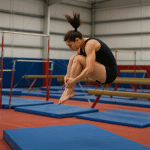Every four years, gymnasts from around the world gather to compete at the Olympic Games, the ultimate goal for many athletes. But how do gymnasts qualify for the Olympics? In this article, we will answer that question.

The Basics of Olympic Gymnastics
First, let’s review the basics of Olympic gymnastics. There are three types of gymnastics events at the Olympics: artistic gymnastics, rhythmic gymnastics and trampoline. Artistic gymnastics includes events like floor exercise, balance beam, vault, and uneven bars, while rhythmic gymnastics involves choreographed routines with equipment like ribbons and hoops.
The trampoline event includes both individual and synchronized events in pairs.
Each country can send a team of gymnasts to compete in the Olympics and individual gymnasts who meet certain qualifying criteria. In addition, there are limits on the number of gymnasts who can compete from each country.
Qualifying for the Olympics
To qualify for the Olympics, gymnasts must participate in various competitions and meet specific criteria. Here are some of the key ways that gymnasts can qualify for the Olympics:
Winning at the World Championships
Gymnasts who win individual all-around or event medals at the World Championships automatically qualify for the Olympics. In addition, the top three teams at the World Championships also qualify.
Earning Qualifying Scores
Gymnasts can also earn qualifying scores at various competitions leading up to the Olympics, such as the World Cup series, continental championships, and other international events. These scores are used to determine which individual gymnasts qualify for the Olympics.
Qualifying through the Continental Championships
Each continent has its own gymnastics championships, and the top gymnasts from each championship can qualify for the Olympics. For example, the top gymnasts from the Pan American Games can qualify for the Olympics.
How many gymnasts go to the Olympics?
For the Paris 2024 Olympic Games, a total of 318 places are available for gymnasts across the disciplines:
- 96 Female Artistic
- 96 Male Artistic
- 94 Rhythmic
- 16 Female Trampoline
- 16 Male Trampoline
Artistic
Compared to the Tokyo Games, the qualification process for artistic gymnastics has been simplified. The most significant modifications involve the number of gymnasts allowed per team, which is now limited to a maximum of five athletes who can participate in both team and individual competitions.
Additionally, there is a new rule that prevents a country that qualifies for the team event from obtaining more than five individual spots. However, countries that fail to qualify for the team event can earn up to three individual spots.

The majority of the spots for the Olympic team and individual competitions will be allocated during the 2023 World Championships held in Antwerp, Belgium. The qualifications will play a crucial role at multiple levels. Following the qualifications, nine team places will be awarded, and the next three highest-ranked eligible countries will receive one non-nominative place each.
Moreover, the all-around qualifications will determine the eight male and fourteen female gymnasts who will earn their Olympic tickets. The apparatus finals will provide an opportunity for specialists, as the top eligible gymnasts in each apparatus final will secure a place in the Olympics.
Specialists will have another opportunity to qualify through the Apparatus World Cup series in 2024. The two best eligible male and female gymnasts on each apparatus from the Olympic Qualification World Cup Ranking List, based on their best three results out of four in the series, will qualify for the Paris Olympics.
The final chance to qualify will be at the 2024 continental championships, with one All-Around individual place up for grabs for contenders at each continental event.
Rhythmic
There are 24 individual spaces and 14 group spaces up for grabs.

Rhythmic gymnasts had their first opportunity to qualify for the Olympics in Sofia, Bulgaria, during the world championships held in September 2022. The medallists in the individual and group competitions secured places for their countries at the Paris 2024 Games.
The majority of Olympic quotas for rhythmic gymnastics were distributed in Valencia, Spain, during the 2023 World Championships. At the conclusion of the qualification competitions, fourteen spots for the individual competition and five for the group competition were granted to eligible countries.
The final chance to qualify for the Olympics in rhythmic gymnastics will be at the 2024 continental championships, with one place available at each championship for both individual gymnasts and groups.
Trampoline
Trampoline athletes will follow a similar qualifying path as that used for the Tokyo Olympics. Half of the qualifying slots were available at the World Championships in Birmingham, United Kingdom, in November 2023.
The top eight finalists in the individual men’s and women’s trampoline competitions will earn a ticket for their country to the Games, with a limit of one per country.

In case of failure to qualify at the World Championships, the 2023-2024 World Cup Series will provide another chance for the best-placed gymnasts to represent their countries. The remaining spots will be distributed to ensure the representation of all continents, based on the outcome of the 2024 continental championships.
The Importance of Qualifying
Qualifying for the Olympics is a significant achievement for gymnasts. It requires not only skill and dedication but also a lot of hard work and perseverance. Once they qualify, gymnasts have the opportunity to compete on the world’s biggest stage and represent their country with pride.
In Conclusion
In conclusion, gymnasts can qualify for the Olympics by winning at the World Championships, earning qualifying scores at various competitions, qualifying through continental championships, or receiving special invitations. Qualifying for the Olympics is a challenging and rewarding achievement for gymnasts, and it requires a lot of hard work and dedication to get there.
- How to Do a Front Tuck: Step-by-Step Guide To FlipThis detailed guide will clearly explain how to do a front tuck somersault safely and successfully. The front tuck is an advanced skill so therefore… Read more: How to Do a Front Tuck: Step-by-Step Guide To Flip
- How to Do a Back Handspring: Complete Step-by-Step GuideLearning how to do a back handspring is an exciting milestone for any gymnast. It builds confidence, agility, and forms the foundation for advanced tumbling… Read more: How to Do a Back Handspring: Complete Step-by-Step Guide
- How To Get Over a Mental Block In Gymnastics: A Complete GuideGymnastics is a sport that requires not only physical strength and skill but also mental strength. When a gymnast feels like they cannot attempt a… Read more: How To Get Over a Mental Block In Gymnastics: A Complete Guide
- The Best Leotard for Girls in 2025: What to Look ForFinding an ideal leotard for girls isn’t just about picking a dazzling design that sparkles (although it does help!). The leotard has to fit perfectly,… Read more: The Best Leotard for Girls in 2025: What to Look For
- The Best Gymnastics Shorts (Our Top Picks)The best gymnastics shorts are designed to be worn over the top of a leotard providing additional coverage around the upper legs, whilst allowing gymnasts… Read more: The Best Gymnastics Shorts (Our Top Picks)
- Decathlon Leotards – Are They Any Good?If you’re in the market for a new leotard, you may be wondering if Decathlon leotards are any good considering the low cost of their… Read more: Decathlon Leotards – Are They Any Good?






